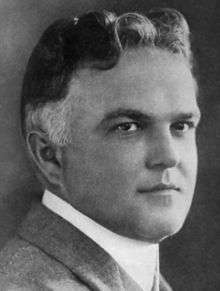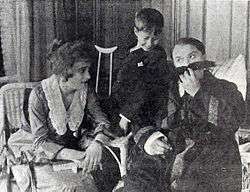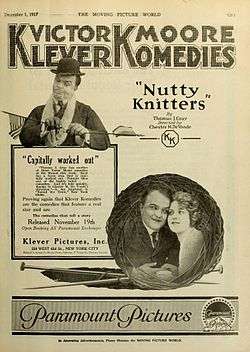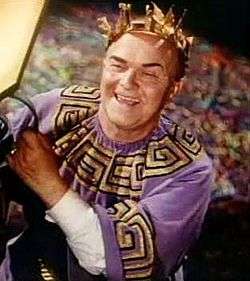Victor Moore
Victor Frederick Moore (February 24, 1876 – July 23, 1962) was an American actor of stage and screen, a major Broadway star from the late 1920s through the 1930s. He was also a comedian, writer, and director.
Victor Moore | |
|---|---|
 Moore, c. 1918 | |
| Born | Victor Frederick Moore February 24, 1876 Hammonton, New Jersey, U.S. |
| Died | July 23, 1962 (aged 86) East Islip, New York, U.S. |
| Occupation | Actor |
| Years active | 1896–1957 |
| Spouse(s) | Emma Littlefield
( m. 1902; died 1934)Shirley Paige
( m. 1942) |
Career
Victor Moore appeared in over 50 films and 21 Broadway shows. His first appearance was on Broadway in Rosemary (1896). He also appeared in George M. Cohan's Forty-five Minutes from Broadway, which opened January 1, 1906, and its sequel, The Talk of New York (1907). He went on to star in shows such as Oh, Kay! (1926) as Shorty McGee, Hold Everything! (1928) as Nosey Bartlett, Gershwin's Of Thee I Sing (1931) as Vice-President Alexander Throttlebottom, Let 'Em Eat Cake (1933), Cole Porter's Anything Goes (1934) as Moonface Martin, and Irving Berlin's Louisiana Purchase (1940) as Oliver P. Loganberry.
Moore's talent was first recognised by screenwriter Beatrice deMille.[1] He made his film debut in 1915. He starred in three films that year, two of which were directed by Cecil B. DeMille – Chimmie Fadden and Chimmie Fadden Out West. He also appeared in Swing Time (1936) with Fred Astaire and Ginger Rogers, Make Way for Tomorrow (1937), The Heat's On with Mae West, Duffy's Tavern (1945), Ziegfeld Follies (1946), It Happened on 5th Avenue (1947), On Our Merry Way (1948), A Kiss in the Dark (1949), and We're Not Married (1952), working with Ginger Rogers for a second time. His last screen appearance was a role as a plumber in The Seven Year Itch (1955).
He worked in film twice with Bob Hope, first in Louisiana Purchase (1941) and again in Star Spangled Rhythm (1942).
Moore made a guest appearance as himself on The Martin and Lewis radio show on August 16, 1949, and was a regular (as himself) on The Jimmy Durante Show.
In 1945 Moore appeared in the Daffy Duck cartoon Ain't That Ducky. He was so pleased with his caricature he offered to add his voice free of charge on the condition that the animators draw him with a little more hair.
Personal life
He was married twice – first to actress Emma Littlefield from 1902 until her death on June 25, 1934, and then to Shirley Paige in 1942, when Moore was 66 and Paige was 22. The marriage was not publicly announced for a year and a half. They remained married until Victor Moore's death 20 years later.
He had three children with his first wife: Victor, Jr. (1910), Ora (1919), and Robert (1921).
Moore died of a heart attack on July 23, 1962. He was 86 years old. He is interred at Cypress Hills Cemetery in Brooklyn, New York, United States.
Legacy
The Victor Moore Bus Terminal and business arcade at the New York City Subway's Roosevelt Avenue / 74th Street station in Jackson Heights, Queens was named for him when it opened in 1941.[2][3] In 2005, the arcade was replaced by an Intermodal Transportation Complex serving the same subway and bus lines.[4]
Filmography



Silent films
|
Sound films
|
Radio appearances
| Year | Program | Episode/source | |
|---|---|---|---|
| 1944 | Amos 'n' Andy | Between Life and Death | |
| 1947 | Lux Radio Theatre | It's a Wonderful Life[5] | |
| 1948 | Hallmark Playhouse | Old Man Minnick[6] |
References
- "Beatrice deMille – Women Film Pioneers Project". wfpp.cdrs.columbia.edu. Retrieved 2018-01-16.
- "Bus Terminal Opened at Jackson Heights: Victor Moore Enterprise in Queens Lauded by Officials" (PDF). The New York Times. December 12, 1941. Retrieved 1 November 2015.
- "Real Politics Scares L.I.'s 'Senator' Moore". Brooklyn Daily Eagle. April 13, 1941. p. 9. Retrieved 1 November 2015 – via Newspapers.com.
- "Officials Applaud Opening Of Renovated Bus Terminal | www.qgazette.com | Queens Gazette". www.qgazette.com. July 20, 2005. Retrieved November 11, 2012.
- "It's a Wonderful Life (1946)". Retrieved 2017-01-05.
- "Radio's Golden Age". Nostalgia Digest. 41 (2): 40–41. Spring 2015.
External links
| Wikimedia Commons has media related to Victor Moore. |
- Victor Moore on IMDb
- Victor Moore at the Internet Broadway Database

- Victor Moore at Find a Grave
- Victor Moore papers, 1864-1958 [bulk 1890s-1958] Billy Rose Theatre Division, The New York Public Library.